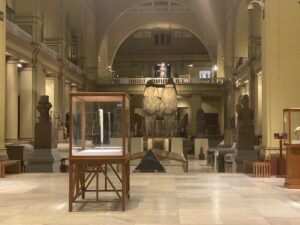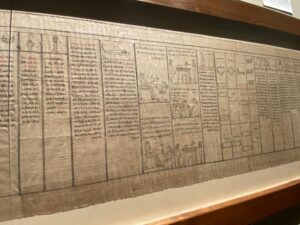Egypt’s Minister of Tourism and Antiquities Ahmed Issa announced in a celebration Monday night the completion the first phase of developing the Egyptian Museum in Tahrir.
The 121-year-old Egyptian Museum in Tahrir is still in the development process while competing with modern museums such as the National Museum of Egyptian Civilisation in Fustat and the Grand Egyptian Museum, the minister said.
“It is a message to the whole world that the Egyptian Museum in Tahrir was and will be one of the most important museums in the world,” the minister added.



The first of the four-phase development project started in 2018 in co-operation with the European Union, represented by heads of Egyptian antiquities departments in five European museums — Christian Greco of the Museo Egizio (Turin), Daniel Antoine of the British Museum (London), Rondot Vincent of the Louvre Museum (Paris), Lara Weiss of the National Museum of Antiquities (Leiden) and Friederike Seyfried of the Egyptian Museum (Berlin).
The project included developing the displays for the prehistoric and ancient galleries on the ground floor. The first royal statue of Egyptian civilisation was also re-displayed in that hall, and the inscriptions of predynastic Tomb 100 Hierakonpolis (c. 3500 BC – Naqada II).
The displays of the Old Kingdom’s galleries include the most important sculpture and engraving of that era (c. 2686-c. 2181 BC), with the re-presentation and restoration of the inscriptions of the tomb of Nefermaat (2575–2551 BC). This comes in addition to the development of Late Period (712–332 BC) galleries which house important antiquities discovered from Tuna El-Gebel such as the rare wooden sarcophagus of Badi Ozir whose engravings are inlaid with precious stones.
On the first floor, the treasures of Tanis (San el-Hagar), a town in the north-east Nile Delta, are on display for the first time. The Tanis artefacts were discovered during World War 2, and were kept in the museum stores. The collection replaces that of Tutankhamun.
Artefacts of the Silver King Psusennes I (1047-1001 BC) of the 21st Dynasty are on display for the first time in a hall named after him. The tomb of Pharaoh Psusennes I is the oldest discovered in the royal necropolis of Tanis.
On the sidelines of the event, a newly discovered papyrus was put on display on the first floor.
Dubbed Papyrus Waziry One, the 16-metre artefact was found during excavations by the Egyptian mission in the Saqqara region led by Mostafa Waziry, Secretary General of the Supreme Council of Antiquities in May 2022, inside the coffin of a person called Ahmose.

The content of this papyrus is from the Book of the Dead and is written in hieratic dating back to the beginning of the Ptolemaic era (300 BC). Most of the text is written in black ink, while some is in red. It contains 113 spells from the Book of the Dead.
Christian Greco, Director of the Egyptian Museum in Turin and Head of the Five European Museums Alliance; Ambassador Christian Berger, chief of the European Union Delegation to Egypt, and and the ambassadors of France, Britain and Italy attended the event.






Discussion about this post